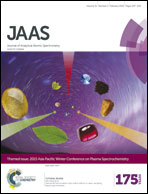Analysis of high-precision vanadium isotope ratios by medium resolution MC-ICP-MS
Abstract
We present and verify a new method to measure vanadium isotope ratios using a Thermo Scientific Neptune multi-collector inductively-coupled plasma mass spectrometer (MC-ICP-MS) operated in medium mass resolution mode. We collect masses 48 through 53 simultaneously using the L2, L1, Center, H1, H2 and H3 collectors. The Center cup is equipped with a 1012 Ω resistor, H1 is equipped with a 1010 Ω resistor, while the rest of the collectors have standard 1011 Ω resistors. Unlike previous low-resolution methods, the use of medium mass resolution (ΔM/M ∼ 4000) permits separation of V, Ti and Cr isotopes from all interfering molecular species representing combinations of C, N, O, S, Cl, and Ar. We show that the external reproducibility follows a power law function with respect to the number of V+ ions collected and achieve an external reproducibility of ±0.15‰ with total V+ ion beam intensities of ∼1 nA. The separation of interfering molecular species from the V mass spectrum reduces the V requirement for precise isotope data to as little as 200–300 ng V per analysis—a reduction of ∼90% compared with previous methods—making several low-V matrices amenable to V isotope analysis.


 Please wait while we load your content...
Please wait while we load your content...